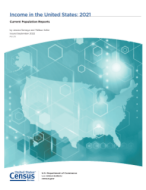Income in the United States: 2021
Income in the United States: 2021
Introduction
This report presents estimates on income, earnings, and inequality in the United States for calendar year 2021, based on information collected in the 2022 and earlier Current Population Survey Annual Social and Economic Supplements (CPS ASEC) conducted by the Census Bureau. Estimates for 2020 in this report will not match those published last year due to the implementation of the 2020 Census-based population controls. Appendix B provides details.
The income estimates in the main sections of this report are based on the concept of money income, as measured by the CPS ASEC. It includes all income received by each person in the household who is aged 15 and older, excluding certain receipts such as capital gains. Money income is pretax and does not include stimulus payments and tax credits such as those from the American Rescue Plan Act (ARPA). Appendix A provides a detailed explanation of how income is measured using the CPS ASEC. For post-tax household income estimates that include stimulus payments and tax credits, refer to Appendix C.
Highlights
- Real median household income was $70,784 in 2021, not statistically different from the 2020 estimate of $71,186 (Figure 1 and Table A-1).
- Based on the money income Gini index, income inequality increased by 1.2 percent between 2020 and 2021; this represents the first time the Gini index has shown as annual increase since 2011 (Figure 3 and Table A-3).
- Between 2020 and 2021, the change in the number of total workers was not statistically significant; however, there was an increase of about 11.1 million full-time, year-round workers (from approximately 106.3 million to 117.4 million), suggesting a shift from working part-time or part-year in 2020 to full-time, year-round work in 2021 (Table A-6).
- The real median earnings of all workers (including part-time and full-time workers) increased 4.6 percent between 2020 and 2021, while median earnings of those who worked full-time, year-round decreased 4.1 percent (Figure 4).
- Real median post-tax household income in 2021 was not statistically different from 2020 (Table C-1).
- In contrast to the 1.2 percent increase in the Gini index using pretax income between 2020 and 2021, the annual percent change in the Gini index calculated by post-tax income was not statistically significant (Table C-3).
Tables
Income:
Income Inequality:
Earnings:
Post-Tax Household Income:
Figures
Income:
Income Inequality:
Earnings:
For More Information
To adjust for changes in the cost of living over time, historical income estimates in this report are expressed in real or 2021 dollars. This inflation adjustment is based on the Consumer Price Index for all Urban Consumers Retroactive Series (R-CPI-U-RS) for 2021 and earlier years, which measured a 4.7 percent increase in consumer prices between 2020 and 2021. More information on the R-CPI-U-RS and the index values for 1947 to 2021 are available in Appendix A. For an in-depth discussion of the effects of using different inflation indices on household income estimates, and information on a proposed change to the index used in this report, refer to Appendix D.
For information on confidentiality protection, sampling error, nonsampling error, and definitions, see https://www2.census.gov/programs-surveys/cps/techdocs/cpsmar22.pdf [PDF - <1.0 MB].
The Census Bureau reviewed this data product for unauthorized disclosure of confidential information and approved the disclosure avoidance practices applied to this release. CBDRB-FY22-357.
Others in Series
Publication
Publication
Visualization








